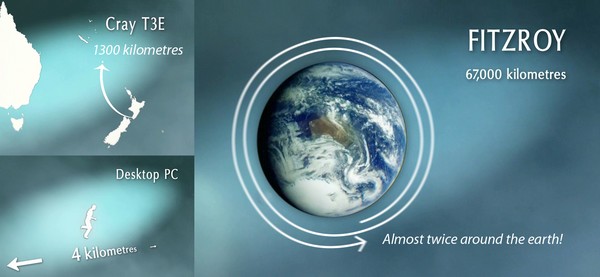Supercomputer will 'prepare for the future by solving tomorrow's problems today'
Thursday 22 July 2010, 7:40AM
By NIWA
366 views

One of the most powerful supercomputers of its kind has been switched on at the National Institute of Water & Atmospheric Research (NIWA).
The new $12.7 million supercomputer is turning its computational might to problems of national and international significance – from climate change and natural hazards forecasting to modelling the human body.
NIWA Chief Executive John Morgan says that the new computer is one of the most significant single investments in science in New Zealand and it will provide benefits for all New Zealanders.
The IBM p575 POWER6 supercomputer is one of the most powerful computers in the world for use in environmental research and forecasting and the most powerful of its kind in the southern hemisphere.
Housed in a specially-constructed computer room at NIWA’s Greta Point base, “FitzRoy” has 100 times the power of NIWA’s existing supercomputer, equivalent to about 7000 laptops working simultaneously. When fully installed, it will weigh 18 tonnes - the floor has had to be custom-strengthened to hold its weight.
The supercomputer will improve scientists’ ability to forecast the impacts of severe weather events such as flooding, storm surge and inundation. It will also be used to model climate change, river flow, ocean levels and wave patterns, to help the country prepare for the future.
“One of the key questions that we’re trying to solve with this machine is: ‘If you knew what was going to happen tomorrow, would you do something differently today?’” said Mr Morgan.
“More accurate forecasts of the natural environment are essential to the future growth of New Zealand’s important industries like farming, horticulture, and the infrastructure and renewable energy sectors.”
An economic study of a similar computer used by the UK Met Office found the benefit to cost ratio was nine times the cost of the computer, based on its ability to improve flood forecast lead times.
Flooding remains New Zealand’s most costly year-on-year physical hazard – claims from damage caused by weather events in July and August of 2008 are estimated at $68 million, according to the Insurance Council. The 2004 Central North Island floods resulted in insurance claims of more than $400 million.
FitzRoy will be available for use by scientists around the country, enabling them to conduct research on grand challenge problems in the fields of energy, weather and climate modelling.
Under the international Physiome project co-led by project leader Professor Peter Hunter, University of Auckland bioengineers will put it to work on creating computer models of the human body. The models will incorporate biochemistry, biophysics and the anatomy of cells, tissue and organs to provide new approaches to diagnosing and treating patients and to help in the development of new medicines.
“The body has to obey the laws of physics, so by using mathematical equations we’re able to better understand how you as an individual operate,” said Professor Hunter. “I have no doubt the key to healthcare in 20 years time will be to have a high quality, predictive and personalised representation of your body by using maths.”
Professor Hunter, who has been working on the international project since it began in 1997, has used a number of supercomputers in that time, but has not had access to one for the past three years. “The ability to access NIWA’s IBM supercomputer is exciting for the project.”
On FitzRoy models that used to take 80 minutes to complete on 40% of the old supercomputer will now take 8 minutes on about 4% of the new system.
It is able to perform 34 trillion (34 million million) calculations per second and this will increase to 65 trillion calculations per second after an upgrade in 2011.
It has 500,000 Gigabytes of disk storage (to increase to 2 million Gigabytes next year) and its two tape libraries will hold another 5 Petabytes (5 million gigabytes) of data - the equivalent of a 3000 year-long MP3 file.
“To have access to such an incredibly high-powered supercomputer opens up a whole new world for NIWA and for New Zealand science” Mr Morgan said.
The supercomputer is called FitzRoy after Robert FitzRoy, a 19th century scientist, surveyor and hydrographer. He captained the Beagle on Charles Darwin’s famous 1831 voyage. He founded the forerunner to the UK Met Office (1854), was the second Governor of NZ from 1843 where he, among other things, insisted that the New Zealand Company pay Maori a realistic price for the land they claimed to have purchased. He was also the first person to do ‘data assimilation’ and produce a ‘weather forecast’.